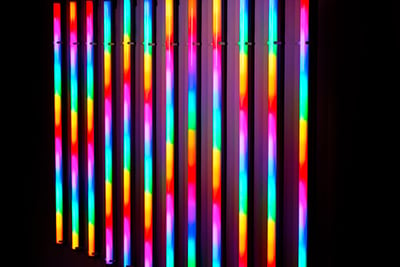Driven by a growing demand for customization, energy efficiency, comfort, and intelligent design, the new wave of lighting controls is about more than just technology and energy savings; it’s about customized, more human environments.
With an array of sophisticated control methods at your fingertips — from intuitive app-based systems to advanced sensors that adapt to our movements and natural light — it’s never been easier to help your commercial LED customers slash energy usage while getting the perfect lighting.
Ready? Let's dive in!
To jump to a specific section, click on one of the links below.
Table of Contents:
1. Types of LED Lighting Control Systems
2. How LED Lighting Controls Work
3. Commercial Applications for LED Lighting Controls
4. Trends in Lighting Controls: What’s Next
5. Use Cases and Settings for LED Lighting Controls
6. LED Lighting Control Regulations
7. Rebates for LED Lighting Controls
8. Roadblocks You Might Encounter When Implementing Controls
9. The Litetronics Difference in LED Lighting Controls
10. Why Choose Litetronics for LED Lighting Controls?
Types of LED Lighting Control Systems
The three major types of lighting control systems are:
Standalone Devices
Standalone control devices are designed to autonomously manage one or more light fixtures connected to a switch leg. These devices are usually connected directly to the AC power line to control the lighting directly. Examples are toggle switches, motion detectors, timers, and dimmers.
They’re popular because they’re simple to install and don’t have to be integrated with a lighting controls system. But they require separate tuning — and combining various control methods on one circuit can result in overly complicated wiring configurations.
Related Reading: Bright Ideas on Installing Dimmable LED Lighting
Room-Based Control Systems
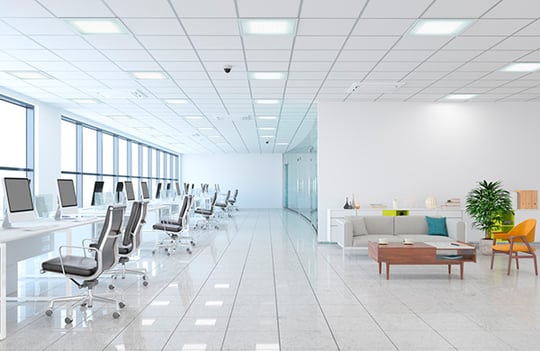 These include a package of lighting controls and input devices and are designed to control all the lighting in a single room, like a conference room.
These include a package of lighting controls and input devices and are designed to control all the lighting in a single room, like a conference room.
They’re popular because they’re designed to comply with energy codes and require minimal installation.
A traditional room-based controls package includes:
- Manual switch, occupancy, and light sensor inputs
- 2-3 relays for switching
- 2-3 dimming outputs for dimming
- Ethernet cabling and low voltage wiring to connect switches and sensors to the controller
- Line-voltage wiring to connect the lighting controllers and the luminaires
- A controller for dimming, installed near the luminaires
Centralized Building Control Systems
Traditional building-level lighting automation uses central control panels located in areas like electrical rooms. These panels contain relays, contactors, circuit breakers, or dimmer modules and manage both low-voltage control signals and line-voltage outputs to the lights.
Intelligent panels also incorporate a lighting controller for mapping input devices to lights and scheduling. They allow for local override via switches to prevent lights from turning off automatically after hours.
While this system centralizes control and can integrate with building management systems, it limits flexibility in control zoning due to the need for low-voltage wiring connections back to the panel for each zone.
Related Reading: Delivering on the Promise of Smart LED Lighting
How LED Lighting Controls Work
From sophisticated wireless systems to tried-and-true dimming technologies, here's a look at the innovative control methods available:
Microwave Detection
Using radio signals, microwave sensors detect movement by bouncing signals off objects to determine direction and speed. This technology is especially effective in conjunction with daylight harvesting, adjusting indoor lighting based on the natural light available, ensuring optimal lighting conditions and energy savings.
Passive Infrared (PIR)
PIR sensors detect the heat signatures of moving objects, making them ideal for applications where precise motion detection is required. Some systems combine microwave and PIR technologies to enhance detection capabilities, such as in restrooms where occupants may not be directly visible, ensuring lights remain on for comfort and safety.
Bluetooth Control
Embrace the convenience of app-controlled lighting with Bluetooth technology. Each light fixture forms part of a mesh network, allowing for seamless communication across buildings or campuses. This method supports a wide range of controls, from dimming to switching, all from a smartphone or tablet, offering unparalleled control and flexibility.
DMX (Digital Multiplex)
A staple in theatrical and entertainment settings, DMX is a protocol designed for controlling complex lighting arrangements, including effects machines and animatronics. Its robust control capabilities make it perfect for creating dramatic lighting scenes and effects.
0-10V Dimming
A straightforward and widely used method for dimming lights, the 0-10V system allows users to adjust the brightness of lights through a simple voltage scale. This analog control method is compatible with many commercial lighting systems, providing a reliable solution for scalable light dimming.
Pulse Width Modulation (PWM)
PWM dimming controls the brightness of LED lights by rapidly turning them on and off at frequencies imperceptible to the human eye. The perceived brightness is adjusted by varying the duty cycle of these pulses, providing precise control over lighting levels without impacting the lifespan of the LEDs.
Each of these control methods offers unique advantages and applications, from enhancing energy efficiency to creating atmospheric lighting effects. Whether you're designing a state-of-the-art office space or setting the mood in a theatrical production, there's a lighting control solution to meet every need.
Commercial Applications for LED Lighting Controls
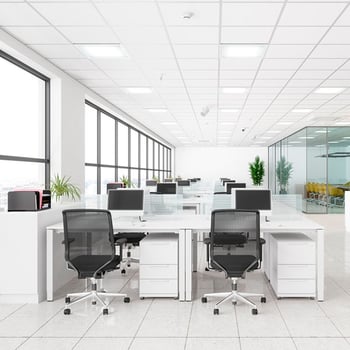
LED lighting controls can be used to reduce energy use, create colored lighting, reduce stress on the eyes, and meet other needs of room occupants. Here are a few uses:
Motion Sensing and Sensitivity Control
Some controls are designed to sense motion to save energy when a room isn’t in use. There are two main types of motion-sensing controls.
- Occupancy: Occupancy sensors automatically turn lights on or off based on whether the room is occupied or not. They automatically turn on when the room is inhabited. They’re common in small spaces like office buildings and public restrooms and are used to save energy when a space isn’t being used.
- Vacancy: Vacancy sensors work in much the same way as occupancy sensors, except they require the light to be turned on manually before the occupancy sensor turns it off after a certain period of being vacant.
Related Reading: Harnessing Occupancy Sensors for Energy Savings & Safety
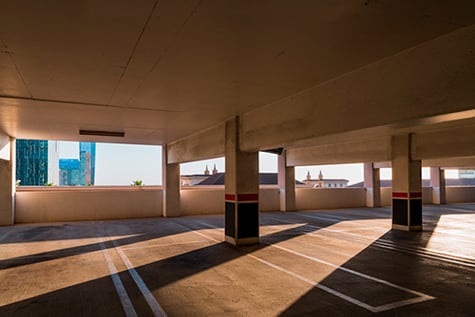 Daylight Harvesting and Sensitivity Control
Daylight Harvesting and Sensitivity Control
Daylight harvesting is an energy management system that reduces the need for electric light based on the available natural light in a space. It’s common in buildings with large windows, skylights, clerestory, and parking garages, where lighting around the perimeter self-adjusts based on the amount of daylight available and according to municipal codes.
Calibration to Ambient Light
This control in lighting systems detects the room's light levels to adjust the brightness of lights automatically, creating a comfortable environment.
Calibration is necessary to tailor the sensor's response to specific room conditions, ensuring optimal operation. This involves turning on all room lights to their fullest and removing the device's faceplate for direct sensor access. This simple process allows the system to adapt its lighting automatically.
Grouping
Grouping is a way of controlling several lights at the same time while also allowing for individual controls. One use might be an office building filled with individual cubicles. You can turn the lights for the entire room on or off or allow each cubicle occupant to control the light directly over their desk.
Scenes
Scene controls allow you to group certain lights, light levels, and other aspects of LED lights to set the right ambience at the flip of a switch or based on preprogrammed settings. It’s useful for conference rooms, for example, where you might have all the lights dimmed to a certain level to reduce glare on the display screen while allowing the speaker enough light to read their notes. Or in a restaurant, lights can be bright over cooking areas, but dim and cozy in the eating area.
Related Reading: Restaurant & Bar LED Lighting
Scheduling
Some controls allow the user to schedule when a light comes on or goes off. Ways to schedule this include:
|
Calendar-day scheduling allows you to turn off the lights on days when no one will be in a building. It’s common in businesses that are only open Monday to Friday, so lights are scheduled to automatically be off on the weekends unless they’re manually turned on. |
Like calendar-day scheduling, time-of-day scheduling allows you to schedule lights to be off before and after a certain time, like before employees arrive at a building and after they leave for the night. |
|
Calendar-day and time-of-day scheduling are often used to comply with local ordinances that specify how long outdoor lights can be on outside of normal operating hours. For motion-controlled lighting, it may specify how long the lights can be on after sensing motion — or how bright they can be to avoid disturbing nearby residents. |
|
Other forms of scheduling include:
- Delay Scheduling: This allows the user to pick a time (e.g., a minute) after which the lights will go off when no motion is detected.
- Astronomical Clock Adjustments: This application takes daylight scheduling to the next level by automating it. These smart systems account for sunrise and sunset depending on time of the year, time zones, and daylight savings time.
Color Controls
Color Tuning/Dynamic Tuning
LEDs come in a variety of colors. By separately dimming these colors, you can create virtually any color imaginable. This approach, called color tuning, is frequently used in entertainment and signage. To maintain this color automatically, dynamic tuning lets you save the settings to return to the same color later.
Tunable White
Tunable white is the same concept as color tuning, except a variety of cool and warm white LEDs are used instead of various colors to produce warm or cool white hues more suitable to studying, relaxation, or other needs.
RGB
An abbreviation of “red, green, blue,” this application allows the user to change the colors of the light output. It’s commonly used in car washes and entertainment and hospitality applications.
Related Reading: A Guide to Understanding CRI in Lighting
Energy Monitoring
This application allows a user to see the energy use of their LED lights and controls and adjust each to maximum energy savings. It’s especially useful for businesses that want to keep a close eye on their energy use.
Trim Settings
Trim settings can be used to set maximum (high-end) and minimum (low-end) available light levels from dimmers.
- Maximum Trim (High End): High-end trim settings can be used to save energy or extend longevity of an LED system due to heat load and drive current.
- Minimum Trim (Low End): Low-end trim settings can be used to adjust the lights for the best performance.
- Percent of Trim: This setting can be used to set a percentage of brightness for a dimmer instead of manually tuning it.
Trends in Lighting Controls: What’s Next
Luminaire-Level Lighting Controls (LLLCs)
These integrate sensors and controls directly into each light fixture, giving precise control over lighting on an individual basis. The LLLC approach is exciting to many builders because of its flexibility and responsiveness, as well as its potential to significantly reduce energy usage. Plus, it can provide detailed data on how spaces are used, which is a bonus for optimizing energy efficiency.
Networked Lighting Controls (NLCs)
These are programmable, digitally connected fixtures and control stations. These systems enhance energy efficiency, offer unmatched flexibility and scalability, and introduce smart features like occupancy sensing and daylight harvesting. NLCs stand out for their ability to simplify modifications, reduce wiring complexity, and provide valuable data insights.
Tunable White Controls
Tunable white controls are growing in popularity because they allow for cooler lights, thought to increase alertness, but also shift to warm dim similar to incandescent and halogen. That makes it a great fit for schools and hospitality, residential, and office buildings. Tunable white can be effective to mimic the human circadian rhythm.
Wireless/Bluetooth Lighting
Growing demand for energy efficiency and smart devices has led to an increase in the popularity of wireless lighting. People also like they can be easily controlled from a smartphone or other mobile device. Globally, the smart lighting market is expected to grow 22.1% by 2030.
Use Cases and Settings for LED Lighting Controls
LED lighting controls are used in schools, health care, office buildings, industrial spaces, and homes to save energy and create the right lighting for an occasion. Here are some ways they’re used in different settings.
Schools
 Manual Controls: In a classroom, manual controls can be used to dim lighting for presentations, to turn them off when not in use, or when viewing educational videos.
Manual Controls: In a classroom, manual controls can be used to dim lighting for presentations, to turn them off when not in use, or when viewing educational videos.- Occupancy Sensing: Occupancy sensing in schools can be a great way to save energy when a classroom isn’t occupied. According to The Lawrence Berkeley National Laboratory, occupancy sensing can save schools an average of 24% on their energy costs.
- Daylight-Responsive Control: Daylight harvesting can be used in new-build school buildings to decrease energy use in areas with more natural light, like cafeterias and atriums.
Healthcare
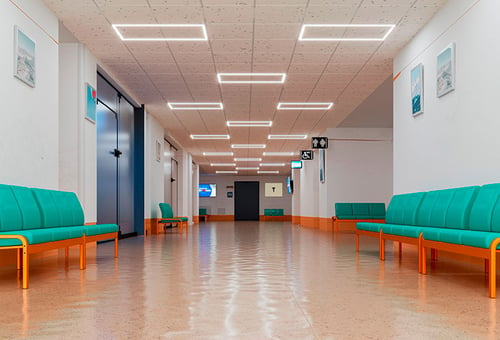 A doctor’s office will have many of the same applications and concerns as other offices. But because hospitals operate 24 hours a day, they may have some unique needs. You’re not likely to find time-of-day controls in a hospital, for example. But they may use vacancy or occupancy controls to reduce energy consumption in unused rooms. And dual-purpose fixtures that allow both a patient and staff to control the intensity of overhead light are common.
A doctor’s office will have many of the same applications and concerns as other offices. But because hospitals operate 24 hours a day, they may have some unique needs. You’re not likely to find time-of-day controls in a hospital, for example. But they may use vacancy or occupancy controls to reduce energy consumption in unused rooms. And dual-purpose fixtures that allow both a patient and staff to control the intensity of overhead light are common.
Learn more about LED lighting in hospitals and healthcare facilities,
including how to get more jobs in these settings.
Industrial
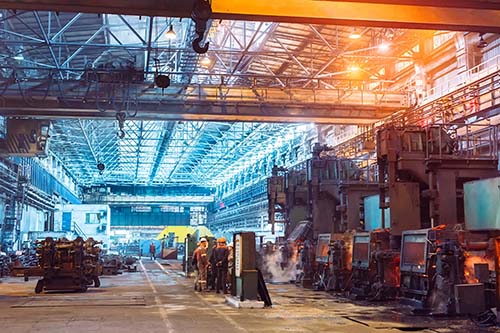 Industrial facilities may have special needs for lighting controls depending on factors such as the needs of the employees, the task at hand, eye adaptivity, rotating equipment and tooling, and products being produced. For instance, the color and quality of lighting may adversely affect product quality, (e.g., beer or soda in bottling plants), resulting in poor taste or decreased shelf life.
Industrial facilities may have special needs for lighting controls depending on factors such as the needs of the employees, the task at hand, eye adaptivity, rotating equipment and tooling, and products being produced. For instance, the color and quality of lighting may adversely affect product quality, (e.g., beer or soda in bottling plants), resulting in poor taste or decreased shelf life.
Another consideration for industrial applications is motion detection. If the delay timers sense a vacant room, but in reality, a mechanic is working under a machine and the light is extinguished, safety is of utmost concern.
Ambient temperature is an issue with PIR infrared motion detection. A hot facility could impact the ability for the motion sensor to sense the heat signature of moving equipment or human bodies.
Learn more about LED lighting in industrial facilities, including
how to get more jobs in these settings.
Offices and Government
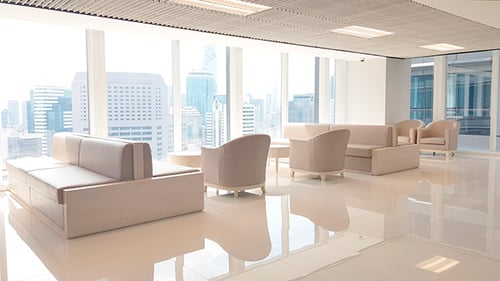 Commercial building energy codes require buildings to have light-reduction capability. Fortunately, there are plenty of options and various use cases for reduced lighting in an office setting.
Commercial building energy codes require buildings to have light-reduction capability. Fortunately, there are plenty of options and various use cases for reduced lighting in an office setting.
- Time-Based Control: Time-based controls are frequently used in office settings to reduce energy costs by setting overhead lights to automatically go on shortly before employees arrive and shut off shortly after they leave.
- Manual Control: Manual controls are familiar to anyone who has ever worked in an office. They can be as simple as light switches, flipped on or off when a room is empty, or light isn’t needed. Manual dimmers are also commonplace in many commercial office buildings.
- Vacancy Sensing: This is another common lighting control used in an office. It’s ideal for smaller, enclosed spaces like private offices, but they can also be used in open office spaces, either as part of the luminaire or when remotely mounted.
- Daylight-Responsive Control: Daylight harvesting controls can be used in office areas with lots of natural light. It’s frequently used in open-concept office layouts with dimming controls to avoid the disruption of lights turning on or off during meetings.
Learn more about LED lighting in offices and in government buildings,
including how to get more jobs in these settings.
Retail
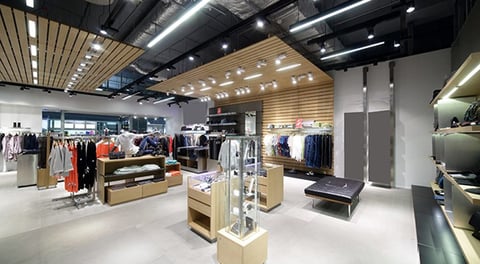 Retail spaces use many of the same controls as office buildings, but they may incorporate specialized controls, like RGB applications for colorful signage and displays. Retail spaces also have plenty of opportunities for grouping, scheduling, and daylight harvesting, creating a more engaging customer experience with less energy usage.
Retail spaces use many of the same controls as office buildings, but they may incorporate specialized controls, like RGB applications for colorful signage and displays. Retail spaces also have plenty of opportunities for grouping, scheduling, and daylight harvesting, creating a more engaging customer experience with less energy usage.
LED Lighting Control Regulations
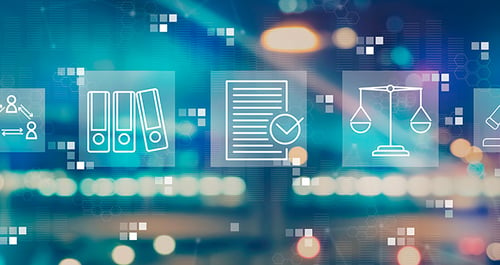 Regulations around lighting controls vary based on your location. Some states or municipalities will have their own codes, so you’ll want to research them before implementing controls. Here are some of the regulations to note.
Regulations around lighting controls vary based on your location. Some states or municipalities will have their own codes, so you’ll want to research them before implementing controls. Here are some of the regulations to note.
International Energy Conservation Code (IECC) 2021
The 2021 iteration of the IECC emphasizes automatic reduction or shutoff of lighting based on occupancy, timed events, or ambient light levels.
This code mandates various lighting controls, including automatic shutoff, light reduction, and daylight-responsive controls, alongside manual controls for occupant convenience and energy savings. Zoning restrictions ensure independent control of lighting where necessary, with exemptions for emergency areas and exit passageways.
ASHRAE/IES 90.1
The ASHRAE/IES 90.1 standard is a cornerstone for building energy efficiency, co-developed by the American Society of Heating, Refrigerating and Air-Conditioning Engineers (ASHRAE) and the Illuminating Engineering Society (IES).
This standard progressively raises the bar for energy performance in new and refurbished buildings. Over time, it has evolved to include more stringent requirements for LED lighting due to advancements in technology and increased awareness of energy conservation. The 2016 version was recognized by the U.S. Department of Energy as the national energy reference standard, compelling state building codes to incorporate it or an equivalent standard by 2020.
California's Title 24 Energy Code
California's Title 24 is particularly noteworthy for its rigorous approach to energy efficiency, including detailed requirements for LED lighting controls. This code serves as a model for other jurisdictions, demonstrating the feasibility and benefits of stringent energy standards.
Title 24 has been a driving force in the adoption of LED lighting, leveraging technology advancements to achieve significant energy savings.
LED-Focused Codes and Standards
Modern energy codes and standards increasingly focus on LED technology due to its high efficiency and potential for energy savings. For instance, ANSI/ASHRAE/IES Standard 90.1-2019 has transitioned to an all-LED baseline for developing lighting power density values. This shift underscores the growing predominance of LED lighting in meeting energy efficiency targets.
Furthermore, the integration of LED lighting into codes reflects broader trends in environmental stewardship, operational cost savings, and the incorporation of advanced technologies.
Human-Centric and Environmentally Friendly Standards
Emerging standards such as the U.S. Green Building Council’s LEED and the International Well Building Institute’s WELL emphasize the importance of user-friendly and environmentally sustainable lighting systems.
These standards promote highly controllable LED lighting systems that support occupant comfort and well-being, aligning with the concept of human-centric lighting (HCL). HCL focuses on the impact of lighting on human circadian rhythms, health, and well-being, indicating a future where lighting standards increasingly address human and environmental needs.
Compliance and Beyond
Compliance with these regulations is just the starting point. Forward-thinking companies and professionals should also consider the broader implications of these standards on building design, occupant health, and environmental impact.
Staying informed about evolving codes and establishing partnerships with leading LED lighting suppliers can provide a competitive edge, ensuring that lighting projects not only meet current standards but are also poised to adapt to future developments.
Rebates for LED Lighting Controls
 Rebates for LED lighting controls can significantly lower the cost of upgrading to more energy-efficient lighting solutions. These incentives range from straightforward rebates that reduce the initial purchase cost to more complex programs offering tax credits or financing options.
Rebates for LED lighting controls can significantly lower the cost of upgrading to more energy-efficient lighting solutions. These incentives range from straightforward rebates that reduce the initial purchase cost to more complex programs offering tax credits or financing options.
However, the availability and specifics of these rebates can vary greatly depending on where you live. Different states, cities, and utility companies offer unique incentives designed to encourage the adoption of LED lighting technologies.
Here are a few of the existing rebates:
- Mass Save offers incentives to Massachusetts residents for indoor and outdoor LED lighting and controls, including instant incentives on lighting equipment, retrofit lighting upgrades, and building energy assessments.
- Los Angeles Department of Water and Power (LADWP) provides a Commercial Lighting Incentive Program (CLIP) with various tiers of rebates for different types of lighting upgrades and controls, including sensor-based controls such as occupancy/vacancy controls and daylight controls.
- Other location-specific LED lighting rebates exist, including from ConEdison on the East Coast and the ComEd Energy Efficient Program for Businesses in the Midwest.
To find more rebates for your specific location and use cases, use our rebate finder tool.
Roadblocks You Might Encounter When Implementing Controls
Here are a few common issues when using LED lighting controls and how to address them.
- Lack of Installation Expertise: Proper installation by knowledgeable installers or contractors is crucial. A common issue is that installers may discard or ignore the included instructions, leading to errors in setup.
- Complexity of Advanced Control Systems: The transition from traditional hard-wired controls to more advanced systems, including Bluetooth and complex control systems, can present significant challenges. Installers comfortable with basic controls may struggle with the commissioning, enabling, scheduling, and programming of more sophisticated systems. It’s also important to ensure that all necessary connections are made, especially for systems that require specific wiring for communication or controls purposes.
- Commissioning and Programming Errors: Proper commissioning is vital for the system to operate correctly. Errors during this phase can lead to system malfunctions. Hiring factory-authorized commissioning agents can ensure that the system is set up correctly, although this may incur additional costs.
- User Errors and Operator Mistakes: Simple operator errors or adjustments can disrupt the system. Instances of overriding switches or incorrect button presses can lead to operational issues. Training for end users on the correct operation of the system can mitigate these issues.

- Documentation and Access to Controls: Loss or misplacement of essential documentation, such as administrative QR codes for app-based control systems, can prevent users from adjusting or controlling the system as needed. It’s also important to ensure that all necessary documents and access tools are readily available to those responsible for the system's operation.
- Interdepartmental Communication and Coordination: In larger installations or organizations, coordination between different departments or individuals responsible for different aspects of the lighting control system can present roadblocks. Effective communication and clear assignment of responsibilities can help avoid situations where necessary access or information isn’t available to those who need it.
The Litetronics Difference in LED Lighting Controls
Litetronics is at the forefront of lighting innovation, making advanced control and efficiency not just a possibility but a reality for a wide range of lighting applications.
Our suite of LED lighting control products is engineered to seamlessly integrate with leading control systems, ensuring flexibility and compatibility across various configurations. Here's how Litetronics transforms spaces with smart, efficient lighting solutions:
Our LED Lighting Control Products
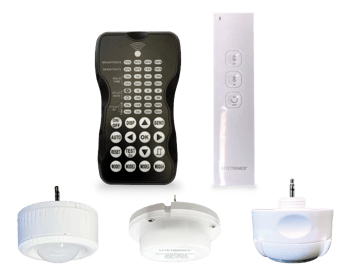 Sensors & Controls: Elevate your lighting efficiency with our state-of-the-art sensors and controls. Designed to optimize energy use and enhance user experience, these products adjust lighting based on occupancy, ambient light levels, and other environmental factors. From simple installations to complex, integrated systems, our solutions provide the flexibility and performance needed to meet any lighting challenge.
Sensors & Controls: Elevate your lighting efficiency with our state-of-the-art sensors and controls. Designed to optimize energy use and enhance user experience, these products adjust lighting based on occupancy, ambient light levels, and other environmental factors. From simple installations to complex, integrated systems, our solutions provide the flexibility and performance needed to meet any lighting challenge.
 Solar Bluetooth Control Switch: Harness the power of solar energy and Bluetooth connectivity with our innovative control switch. This product combines the convenience of wireless control with the sustainability of solar power, offering a versatile and eco-friendly solution for managing lighting preferences.
Solar Bluetooth Control Switch: Harness the power of solar energy and Bluetooth connectivity with our innovative control switch. This product combines the convenience of wireless control with the sustainability of solar power, offering a versatile and eco-friendly solution for managing lighting preferences.
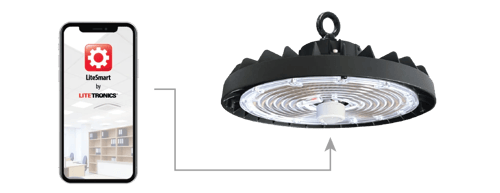 LiteSmart Mobile Lighting Control App: Controls are easier than ever with the LiteSmart app, now DLC certified for higher rebate opportunities. This mobile application provides users with unparalleled control over their lighting environment, allowing for adjustments in brightness, scheduling, and even color temperature with just a few taps on their smartphone or tablet.
LiteSmart Mobile Lighting Control App: Controls are easier than ever with the LiteSmart app, now DLC certified for higher rebate opportunities. This mobile application provides users with unparalleled control over their lighting environment, allowing for adjustments in brightness, scheduling, and even color temperature with just a few taps on their smartphone or tablet.
Or talk to us today!
Why Choose Litetronics for LED Lighting Controls?
![]() Compatibility and Flexibility: Our products are compatible with leading control systems, ensuring they can easily integrate into any existing setup or a new installation.
Compatibility and Flexibility: Our products are compatible with leading control systems, ensuring they can easily integrate into any existing setup or a new installation.
![]() Energy Efficiency: Designed with energy savings in mind, our LED controls help reduce your customers’ carbon footprint and lower utility costs.
Energy Efficiency: Designed with energy savings in mind, our LED controls help reduce your customers’ carbon footprint and lower utility costs.
![]() Enhanced User Experience: With intuitive designs and smart connectivity options, our lighting controls enhance comfort and convenience for users.
Enhanced User Experience: With intuitive designs and smart connectivity options, our lighting controls enhance comfort and convenience for users.
![]() Sustainability: From solar-powered switches to energy-saving sensors, we're committed to offering products that support a healthier planet.
Sustainability: From solar-powered switches to energy-saving sensors, we're committed to offering products that support a healthier planet.
![]() Rebate Opportunities: Many of our products are eligible for rebates, making them an even more cost-effective solution for upgrading any commercial lighting system.
Rebate Opportunities: Many of our products are eligible for rebates, making them an even more cost-effective solution for upgrading any commercial lighting system.
Ready to start using LED lighting controls in your next project? Locate a Litetronics rep near you, or get in touch with us today!

